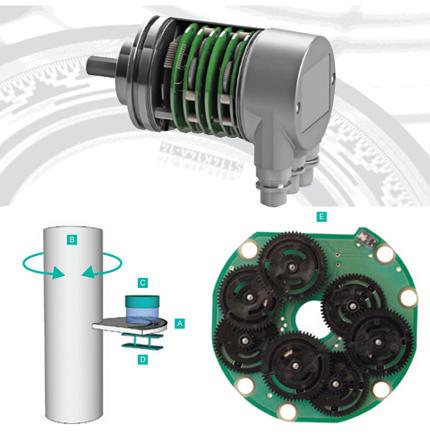Magnetic Measurement Principles
Magnetic rotary encoders determine angular position using magnetic field sensor technology. A permanent magnet a fixed to the encoder’s shaft creates a magnetic field which is sampled by a sensor B that generates an accurate absolute position reading. Signal Processing is the Key to High Performance The technological leap that pushes POSITaL’s IXaRC magnetic encoders to the performance level of optical systems is based on a new generation of sensor systems. The combination of a custom Hall-effect sensor and complex signal processing algorithms running on a powerful 32 bit microprocessor results in a considerably improved resolution and accuracy, along with latency times of only a few microseconds. POSITaL has also implemented an incremental interface and can now offer a complete range of encoder solutions.
Multiturn Innovation
POSITaL can also provide absolute multiturn measurements by means of a revolution counter system that uses an energy harvesting system based on the wiegand effect. This system requires no gears or batteries. Eliminating batteries brings about many advantages. Batteries have a limited lifespan, weigh a lot, and often contain harmful substances. Gear units have disadvantages of their own being large, complex, costly and vulnerable to shock and vibration. Regardless of the rotational speed, even at near-zero, the energy harvesting system generates short, powerful voltage pulses, sufficient to power the counting electronics. The result is a revolution counter that is independent of any external power supply. This technology, which has proven itself since 2005, enables maintenance-free reliable measurement of absolute positions, even in demanding environments, for years to come.
Advantages of Magnetic Encoders
- Robust and durable
- Mechanically simple and economical − no battery, no gear
- Compact design for installation in small spaces
Optical Measurement Principles
A key component of optical rotary encoders is a code disk a mounted on the encoder shaft B . This disk is made of unbreakable plastic that has a concentric pattern of transparent and opaque areas. Infrared light from an LEd C shines through the code disk, onto an array of photoreceptors d . as the shaft turns, a unique combination of photoreceptors are illuminated or blocked from light by the pattern on the disk. For multiturn models, there is an additional set of code discs arranged in a gear train E . as the main encoder shaft rotates, these discs are geared together to turn like the wheels of an odometer. The rotational position of each disc is monitored optically and the output is a count of the net number of rotations of the encoder shaft.
Functionality
POSITaL’s IXaRC optical absolute rotary encoders use highly integrated Opto-aSICs, providing a resolution up to 16 bits (65,536 steps) per turn. For multiturn models, the measuring range is extended by the mechanically geared code disks to as many as 16,384 (214) revolutions.
Advantages of Optical Encoders
- High resolution and accuracy along with excellent dynamic response
- For use in areas with high magnetic fields
- No risk of these devices losing track of their absolute position
- No backup batteries required
Absolute vs Incremental Rotary Encoders
Absolute Rotary Encoders
Absolute rotary encoders are capable of providing unique position values from the moment they are switched on. This is accomplished by detecting the position of a coded element. All positions in these systems correspond to a unique code. Even movements that occur while the system is without power are translated into accurate position values once the encoder is powered up again.
Advantages
- Multiple Interface Options: Analog, Ethernet,
- Fieldbus, Parallel, Serial
- Singleturn and Multiturn Revolution
- Resolution up to 16 bit
- Optical and Magnetic Measuring Principle
Incremental Rotary Encoders
Incremental encoders generate an output signal each time the shaft rotates a certain amount. (The number of pulses per turn defines the resolution of the device.) Each time the encoder is powered on it begins counting from zero, regardless of where the shaft is. Initial homing to a reference point is therefore inevitable in all positioning tasks, both upon start up of the control system and whenever power to the encoder has been interrupted.
Advantages
- A , B, Z, and Inverted Signals as HTL (Push-Pull) or TTL (RS422).
- Any Pulse Count up to 16384 Pulses per
- Revolution Available
- Flexible Scaling Functionality
- Magnetic Measuring Principle

 Hoskin Environnement
Hoskin Environnement
 Hoskin Géotechnique
Hoskin Géotechnique
 Hoskin Instrumentation
Hoskin Instrumentation


 Posez une question sur ce produit
Posez une question sur ce produit



